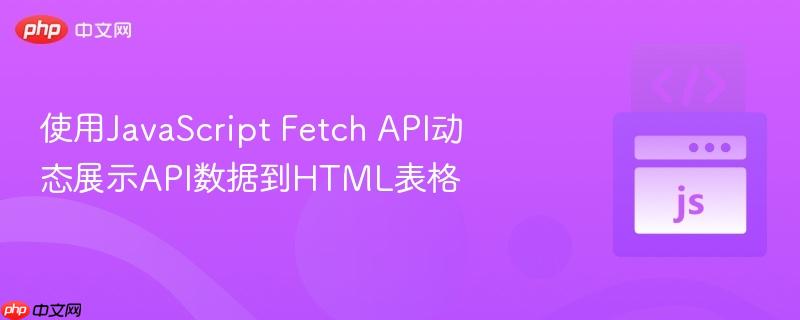
本文详细介绍了如何利用JavaScript的Fetch API从远程接口获取JSON数据,并将其高效地渲染到HTML表格中。教程涵盖了Fetch API的基本用法、正确解析API响应的关键步骤,以及两种DOM操作方法(createElement与innerHTML)的实践与性能考量,旨在帮助开发者构建动态数据展示功能。
Fetch API是现代浏览器提供的一种用于进行网络请求的强大接口,它提供了一种更灵活、更强大的方式来替代传统的XMLHttpRequest。Fetch API基于Promise,使得异步操作链式处理更加简洁。
基本的使用方式如下:
fetch('YOUR_API_ENDPOINT')
.then(response => {
// 检查响应状态,确保请求成功
if (!response.ok) {
throw new Error(`HTTP error! status: ${response.status}`);
}
// 解析JSON格式的响应体
return response.json();
})
.then(data => {
// 在这里处理获取到的数据
console.log(data);
})
.catch(error => {
// 捕获请求或处理过程中发生的错误
console.error('Fetch operation failed:', error);
});在这个例子中,fetch()函数发起一个网络请求,返回一个Promise。.then()方法用于处理Promise的成功状态。第一个.then()通常用于检查HTTP响应状态并解析响应体(例如response.json()解析JSON数据)。第二个.then()则接收解析后的数据进行进一步处理。.catch()方法用于捕获任何在Promise链中发生的错误。
立即学习“Java免费学习笔记(深入)”;
在处理API数据时,首先需要明确API返回的JSON数据结构。错误的字段引用是常见的问题。以本教程使用的API为例:https://www.sponsorkliks.com/api/?club=11592&call=webshops_club_extension。
通过浏览器开发者工具查看其响应,可以发现返回的JSON数据结构如下:
{
"webshops": [
{
"id": "...",
"name_short": "...",
"link": "...",
"orig_url": "...",
"logo_120x60": "...",
// ... 更多字段
},
// ... 更多webshop对象
]
}可以看到,实际的商铺数据位于一个名为webshops的数组中,而不是直接作为根对象。因此,在处理数据时,我们需要从响应数据中提取webshops数组。
一种常见的将API数据渲染到HTML表格的方法是动态创建DOM元素。这种方法直观易懂,通过JavaScript的document.createElement()、appendChild()等方法来构建表格行和单元格。
首先,准备HTML结构和CSS样式:
<!DOCTYPE html>
<html>
<head>
<title>API数据表格</title>
<style>
table {
border-collapse: collapse;
width: 100%;
margin-top: 20px;
}
th, td {
padding: 8px;
text-align: left;
border-bottom: 1px solid #ddd;
}
th {
background-color: #f2f2f2;
}
img {
vertical-align: middle;
}
</style>
</head>
<body>
<table id="api-table">
<thead>
<tr>
<th>名称</th>
<th>URL</th>
<th>Logo</th>
</tr>
</thead>
<tbody>
<!-- 数据将在此处动态加载 -->
</tbody>
</table>
<script>
// JavaScript代码将在此处插入
</script>
</body>
</html>接下来是使用createElement方式填充表格的JavaScript代码。关键在于从data对象中解构出webshops数组,并使用正确的字段名(例如item.name_short、item.link、item.orig_url、item.logo_120x60)。
fetch('https://www.sponsorkliks.com/api/?club=11592&call=webshops_club_extension')
.then(response => response.json())
.then(({ webshops }) => { // 使用解构赋值直接获取webshops数组
const tableBody = document.querySelector('#api-table tbody');
webshops.forEach(item => {
const row = document.createElement('tr');
const nameCell = document.createElement('td');
nameCell.textContent = item.name_short; // 使用正确的字段名
row.appendChild(nameCell);
const urlCell = document.createElement('td');
const urlLink = document.createElement('a');
urlLink.href = item.link; // 使用正确的字段名
urlLink.textContent = item.orig_url; // 使用正确的字段名
urlLink.target = '_blank'; // 建议在新标签页打开链接
urlCell.appendChild(urlLink);
row.appendChild(urlCell);
const logoCell = document.createElement('td');
const logoImg = document.createElement('img');
logoImg.src = item.logo_120x60; // 使用正确的字段名
logoImg.alt = item.name_short;
logoImg.style.maxWidth = '100px'; // 调整图片大小
logoCell.appendChild(logoImg);
row.appendChild(logoCell);
tableBody.appendChild(row);
});
})
.catch(error => console.error('获取或处理数据失败:', error));虽然动态创建DOM元素的方法易于理解,但当需要渲染大量数据时,频繁的DOM操作(如createElement和appendChild)可能会导致性能问题。一种更高效的替代方案是构建一个HTML字符串,然后一次性通过innerHTML属性将其插入到DOM中。
fetch('https://www.sponsorkliks.com/api/?club=11592&call=webshops_club_extension')
.then(response => response.json())
.then(({ webshops }) => {
const tableBody = document.querySelector('#api-table tbody');
// 使用map方法将每个数据项转换为一个HTML行字符串,然后用join('')连接成一个完整的HTML字符串
tableBody.innerHTML = webshops.map(item => `
<tr>
<td>${item.name_short}</td>
<td><a href="${item.link}" target="_blank">${item.orig_url}</a></td>
<td>
<img src="${item.logo_120x60}"
style="max-width:100px;"
alt="${item.name_short}">
</td>
</tr>
`).join('');
})
.catch(error => console.error('获取或处理数据失败:', error));这种方法通过模板字符串(``)和map()、join('')的组合,将所有表格行的HTML内容一次性生成,然后赋值给tableBody.innerHTML。这大大减少了DOM操作的次数,从而提高了渲染性能。
将HTML结构、CSS样式和优化后的JavaScript代码整合在一起,形成一个完整的、可运行的示例:
<!DOCTYPE html>
<html>
<head>
<title>API数据表格</title>
<style>
table {
border-collapse: collapse;
width: 100%;
margin-top: 20px;
}
th, td {
padding: 8px;
text-align: left;
border-bottom: 1px solid #ddd;
}
th {
background-color: #f2f2f2;
}
img {
vertical-align: middle;
}
</style>
</head>
<body>
<table id="api-table">
<thead>
<tr>
<th>名称</th>
<th>URL</th>
<th>Logo</th>
</tr>
</thead>
<tbody>
<!-- 数据将在此处动态加载 -->
</tbody>
</table>
<script>
fetch('https://www.sponsorkliks.com/api/?club=11592&call=webshops_club_extension')
.then(response => {
if (!response.ok) {
throw new Error(`HTTP error! status: ${response.status}`);
}
return response.json();
})
.then(({ webshops }) => {
const tableBody = document.querySelector('#api-table tbody');
tableBody.innerHTML = webshops.map(item => `
<tr>
<td>${item.name_short}</td>
<td><a href="${item.link}" target="_blank">${item.orig_url}</a></td>
<td>
<img src="${item.logo_120x60}"
style="max-width:100px;"
alt="${item.name_short}">
</td>
</tr>
`).join('');
})
.catch(error => console.error('获取或处理数据失败:', error));
</script>
</body>
</html>通过本文的详细教程,我们学习了如何使用JavaScript的Fetch API从远程接口获取JSON数据,并将其高效地渲染到HTML表格中。掌握API响应结构、选择合适的DOM操作方法(createElement或innerHTML)以及实施健壮的错误处理是构建动态Web应用的关键。这些技术是现代前端开发中不可或缺的基础技能。
以上就是使用JavaScript Fetch API动态展示API数据到HTML表格的详细内容,更多请关注php中文网其它相关文章!

HTML怎么学习?HTML怎么入门?HTML在哪学?HTML怎么学才快?不用担心,这里为大家提供了HTML速学教程(入门课程),有需要的小伙伴保存下载就能学习啦!

Copyright 2014-2025 https://www.php.cn/ All Rights Reserved | php.cn | 湘ICP备2023035733号